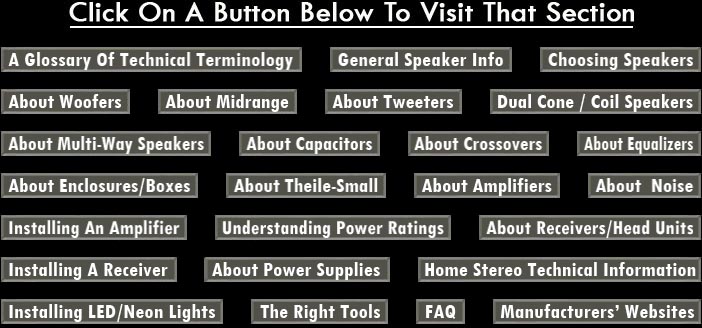


Haas Effect
Also known as precedence effect, describes the human psychoacoustic phenomena of correctly identifying the direction of a sound source heard in both ears but arriving at different times. Due to the head's geometry (two ears spaced apart, sometimes separated by a barrier) the direct sound from any source first enters the ear closest to the source, then the ear farthest away. The Haas Effect describes how humans localize a sound source based upon the first arriving sound, if the subsequent arrivals are between 25-35 milliseconds. If the later arrivals are longer than this, then two distinct sounds are heard. The Haas Effect applies even when the second arrival is louder than the first (even by levels as great as 10 dB.)
Hard Dome (Tweeter)
A characteristic of some Dome tweeters in which the dome is made of some light, hard metal such as neodymium, titanium, or some of the more rigid plastic compounds. The differences in reproduction between hard and soft dome tweeters, are distinctive, but very subtle. Pay close attention to how these sound before purchase.
Harmonic Distortion
A type of Distortion in which resonance or sympathetic ringing vibrations are added to the original sound to produce second and third harmonics of a fundamental tone in a way that was not present in the original signal. Choosing good Drivers and a well-made enclosure design is essential in overcoming this tendency in speakers.
Harness
The universal name for a bundle or loom of wires that compose the wiring for a system.
Hatchback (box or enclosure)
An enclosure of such size and shape as to enable its efficient use in hatchback-style vehicles. Normally, these enclosures are somewhat deeper than standard angled enclosures and have either handles on the end panels or no handles at all.
Headroom
A term related to the dynamic range of amplifiers, used to express in dB, the level between the typical operating level and the maximum output level (onset of clipping). For example, a nominal +5 dBu system that clips at +25 dBu has 20 dB of headroom. Because the term depicts a pure ratio, there are no units or reference-level associated with headroom, only relative "dB." Therefore headroom expressed in dB accurately refers to both voltage and power. Which means the example above has both 20 dB of voltage headroom, and 20 dB of power headroom.
Heat Dissipation
The function of transfering heat away from a component into the air to prevent damage to the output section of an amplifier or the voice coil of a speaker.
Heat Sink
Parts of an amplifier, typically heavy metal "fins," and a section of the frame of the speaker used to conduct and radiate heat away from the ponit of electrical consumption, or motor assembly.
Hertz
The measurement of frequency. One hertz is equal to one cycle per second, or the complete cycle of an alternating (AC) waveform. Higher frequencies are measured in kilohertz, (thousands of cycles per second) Megahertz, (millions of cycles per second), etc.
High Fidelity
A method of sound reproduction that emphasizes the highest possible adherence to the exact character of the original sound. This is a principal that must be paramount in every stage of the recording, transportation, and re-creation of the signal to be fully operational. It is usually the listener's equipment wherein this objective is most seriously compromised.
High Level Input
An audio input configured to accept speaker level signals.
High Power Output
Speaker level outputs driven by an amplifier, typically at least 15 watts RMS per channel.
High Pass Filter
An electronic filter of a type commonly incorporated in Crossover circuits that permits the passage of high frequencies while suppressing lower ones. The place in the frequency spectrum where this occurs is called the crossover point and is different for each set of Drivers being considered. The most basic form of such filter is a non-polarized capacitor. Typical values for such a unit would be in the range of 1 to 100 microfarads.
High Voltage Switching Power Supply
An amplifier's internal power supply that converts the vehicle's 12 volts to higher voltage for improved dynamic range and higher amp output power.
Horn
A type of speaker system now principally used for high-frequency reproduction, but which is capable of full range sound in its largest format. As with those huge alpine horns, even the smallest transducer or diaphragm can produce the lowest sound if the horn is long enough and large enough at its business end. (see Compression Driver above)
Horn Tweeter
A driver consisting of a relatively small emitter surmounted by a curvilinear or exponential horn. This is an effective system for radiating high frequencies in a variety of situations. The size and shape of the horn will usually dictate the pattern and use of the driver. Long horns with narrow apertures, tend to have the narrowest radiation pattern, and are very useful in large listening rooms, especially where highly directional effects, such as surround sound requires, are mandatory. Shallower versions have more general applications, especially in car stereo applications where a wider field of coverage is desired, along with a robust driver that can withstand severe environments. In such situations, a Piezo driven emitter (driver) is highly desirable for its ability to handle high-energy inputs on a variable basis. Horns can be driven by a number of different driver types: Dynamic ,(magnet and coil) Piezo, Electrostatic, Ribbon, and even Gas Plasma have been used effectively for this purpose.
Hum components
The residual artifact harmonics of the AC power supply. In the U.S. the use a 60-Hz system, places the most annoying 2nd and 3rd harmonics at 120 Hz and 180 Hz. For Europe, and other parts of the world using 50-Hz mains, these components fall at 100 Hz and 150Hz. To some extent, this is present with nearly all non automotive sound systems and is generally accounted as noise.
Hyperbaric Resonator Impulse
An audible event characterized by a sudden and often unexpected pressure wave emanating from a vent port with a driver whose energetic and propulsive energy transitions, are generated by a process involving the chemical modification of legumes. This phenomenon frequently produces olfactory irritation in associated groups in consequence. This event is also know as a Farsical Audio Report Transient.
Hypercardioid
A narrower heart-shaped pick-up pattern than that of cardioid microphones















